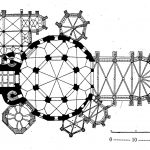
 Research shows that the number eight (8) is used within Christian tradition to relate to the resurrection of the Christ Jesus. Therefore this number is the number to represent the full cycle of God's plan. Although the number seven (7) is usually thought of as the holy number because of the completion of Creation and the Sabbath being on the seventh day, the number eight is the next step. Research also shows that this was a common practice, specifically for the design of baptisteries. The use of eight sides in a baptistery is very interesting because within Christianity it is believed that professing Jesus as Lord and following that with baptism is the process of rebirth. So the question is, was this intended by Charlemagne and his architects? Historians argue that it was intentional. That the knowledge of eight symbolizing the resurrection of Christ Jesus was used to possibly even show the place on earth for spiritual renewal or rebirth for humans. This would suggest a closeness to God through a physical presence within the octagonal structure. Which leaves me with one question for the readers. Knowing that many monasteries were built upon hilltops for physical representation and a spiritual closeness to God, would Charlemagne's use of an octagon in the Aachen Cathedral provide the same effect?
Research shows that the number eight (8) is used within Christian tradition to relate to the resurrection of the Christ Jesus. Therefore this number is the number to represent the full cycle of God's plan. Although the number seven (7) is usually thought of as the holy number because of the completion of Creation and the Sabbath being on the seventh day, the number eight is the next step. Research also shows that this was a common practice, specifically for the design of baptisteries. The use of eight sides in a baptistery is very interesting because within Christianity it is believed that professing Jesus as Lord and following that with baptism is the process of rebirth. So the question is, was this intended by Charlemagne and his architects? Historians argue that it was intentional. That the knowledge of eight symbolizing the resurrection of Christ Jesus was used to possibly even show the place on earth for spiritual renewal or rebirth for humans. This would suggest a closeness to God through a physical presence within the octagonal structure. Which leaves me with one question for the readers. Knowing that many monasteries were built upon hilltops for physical representation and a spiritual closeness to God, would Charlemagne's use of an octagon in the Aachen Cathedral provide the same effect? Sources:
"Aachen Cathedral." Wikipedia, Sep. 6, 2016. https://en.wikipedia.org/wiki/Aachen_Cathedral
"Numbers and Their Meanings." crystalinks.com, 2004. http://www.crystalinks.com/numerology2.html
"The Sabbath Day, Sunday and the Eighth Day." Saint Spyridon Greek Orthodox Church, Mar. 30, 2013. http://www.stspyridons.org/the-sabbath-day-sunday-and-the-eighth-day/



Great post, Ben! I really like how you demonstrate the connection between architecture and religion.
ReplyDeleteI think the cathedral is beautiful and the first picture really shows that. Good find on the connection of the number eight and how that related to Christianity. I do wonder if it was intentional by Charlemagne.
ReplyDeleteI think that your question is very good Roman. It would be hard to conclude that it was explicitly intentional by Charlemagne without written evidence, but Aachen's design connection to other churches that had baptisteries with eight sides to symbolize the connection is evident. Therefore I would argue that there was a known connection by someone involved in the design process.
DeleteBen, this was a very interesting blog. At first, I thought this post was going to be on the history of the Aachen Cathedral and some of the architect. However, you did a unique spin when describing this Cathedral. I think it was interesting that you included the tie between the architecture and religion. I didn't know about the significance of the number eight and it's connection to Christianity. Now I am really curious if the number eight was purposely incorporated into the Aachen Cathedral or if it was merely a coincidence.
DeleteWhen so often people today think of the Middle Ages as dark and bland, it's incredible what beautiful intricacy and thought is put into structures, works of art, and writings. This is a great and thoughtful analysis of Aachen; the geometry is something I never would have thought of examining myself. I wonder how many other medieval structures have such intricately planned symbolic geometrical features that we may overlook today.
ReplyDelete